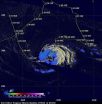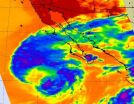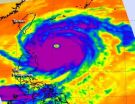(Press-News.org) An isolated outbreak of a deadly disease known as acute hemorrhagic fever, which killed two people and left one gravely ill in the Democratic Republic of Congo in the summer of 2009, was probably caused by a novel virus scientists have never seen before.
Described this week in the open-access journal PLoS Pathogens, the new microbe has been named Bas-Congo virus (BASV) after the province in the southwest corner of the Congo where the three people lived.
It was discovered by an international research consortium that included the University of California, San Francisco (UCSF) and University of California, Davis (UCD), Global Viral, the Centre International de Recherches Médicales de Franceville in Gabon, the Institut National de Recherche Biomédicale, Kinshasa in the Democratic Republic of the Congo, Metabiota and others.
"Known viruses, such as Ebola, HIV and influenza, represent just the tip of the microbial iceberg," said Joseph Fair, PhD, a co-author and vice president of Metabiota. "Identifying deadly unknown viruses, such as Bas-Congo virus, gives us a leg up in controlling future outbreaks."
"These are the only three cases known to have occurred, although there could be additional outbreaks from this virus in the future," said Charles Chiu, MD, PhD, an assistant professor of laboratory medicine at UCSF and director of the UCSF-Abbott Viral Diagnostics and Discovery Center, who spearheaded the UCSF effort to identify the virus. Chiu and his team continue to work on new diagnostics to detect the virus so that health officials in Congo and elsewhere can quickly identify it should it emerge again.
One odd characteristic of the Bas-Congo virus, Chiu said, is that while a number of other viruses in Africa also cause deadly outbreaks of acute hemorrhagic fever—Ebola virus, Lassa virus and Crimean-Congo Hemorrhagic Fever virus to name a few —the new virus is unlike any of them.
Genetically it is more closely related to the types of viruses that cause rabies, which are known to infect people with a very different sort of disease—a neurological illness that is uniformly fatal if untreated but may take months to develop.
An antibody test developed in this study was applied to the one patient who survived and to others who had come into contact with him. It suggested that the disease may be spread from person to person but likely originated from some other source, such as an insect or rodent.
The identity of this animal "reservoir" and the precise mode of transmission for the virus remain unclear and are currently being investigated by Metabiota and the central African members of the consortium through the PREDICT Project of USAID's Emerging Pandemic Threats Program.
How the New Virus Emerged
In the summer of 2009, a 15-year old boy in a small rural community called Mangala village suddenly fell ill and developed a bleeding nose, bleeding gums and bloody vomit. He rapidly worsened, dying within three days of the first signs of illness.
A week later, a 13-year old girl who attended the same school and lived in the same neighborhood as the boy came down with a similar, serious illness. She declined just as rapidly and also died within three days. One week after that, the male nurse who cared for this girl began showing the same symptoms, and he was transferred to a hospital in Boma, a nearby port city that sits along the Congo River upstream from Africa's Atlantic coast.
Members of the consortium, who had initiated a project to diagnose unusual cases of severe hemorrhagic fever, obtained blood samples collected from the nurse by the Congolese doctors and sent them to the laboratory of Eric Leroy, PhD, doctor of veterinary medicine at the Centre International de Recherches Médicales de Franceville in Gabon. There the samples were tested for traces of any known virus, but nothing was found. The Metabiota scientists then solicited the expertise of Chiu at UCSF and Eric Delwart at the Blood Systems Research Institute (BSRI) in San Francisco to aid in the diagnosis.
The researchers ultimately identified a completely new virus as the cause of the mysterious illness through a powerful strategy for identifying novel pathogens known as "deep sequencing," in which millions of DNA sequences are generated from a clinical sample and then pieced together using computer algorithms combined with human analysis.
Distinct Attributes of Bas-Congo
The Bas-Congo virus belongs to a family of viruses known as the rhabdoviruses, a large family of viruses that infect plants, insects and mammals, including humans. The most famous member of this family is the virus that causes rabies. But even among the rhabdoviruses, Bas-Congo is something of an outlier, being very genetically distinct from other members of the family.
What's most unusual about this virus, though, said Chiu, is what it does to people.
No other rhabdoviruses are known to cause the acute, rapid and deadly hemorrhagic fever seen in the three cases in the Congo. Rabies, for instance, can be a deadly disease if untreated, but the course of rabies in humans is nothing like the rapid and deadly onset seen with the Bas-Congo virus. There is some precedent, however, for hemorrhagic disease from rhabdoviruses in the animal kingdom: fish rhabdoviruses are known to cause hemorrhagic septicemia—acute bleeding and death—in affected fish.
The third patient had enormous amounts of BASV in his bloodstream just two days after he fell ill—more than a million copies in every milliliter of blood.
The BASV sequence was also used to design an antibody test for the virus, an effort led by Graham Simmons at the BSRI, another member of the consortium. Antibodies are blood immune proteins produced in response to an infection. The antibody test allowed the researchers to screen both the third patient with acute hemorrhagic fever and other people who had come into contact with the third patient, including the nurse who cared for him in the Boma hospital. High levels of BASV-specific antibodies were found in the third patient, establishing that he indeed had been infected with Bas-Congo virus. The same antibodies were also found in the second nurse, even though he never actually became sick.
"What this suggests is that the disease may be transmissible from person to person—though it's most likely to have originated from some other source," said Nathan Wolfe, PhD, founder and chairman of Global Viral, and a co-author on the paper. "The fact that it belongs to a family of viruses known to infect a wide variety of mammals, insects and other animals means that it may perpetually exist in insect or other 'host' species and was accidentally passed to humans through insect bites or some other means."
INFORMATION:
The article, "A Novel Rhabdovirus Associated with Acute Hemorrhagic Fever in Central Africa" by Gilda Grard, Joseph N. Fair, Deanna Lee, Elizabeth Slikas, Imke Steffen, Jean-Jacques Muyembe, Taylor Sittler, Narayanan Veeraraghavan, J. Graham Ruby, Chunlin Wang, Maria Makuwa, Prime Mulembakani, Robert B. Tesh, Jonna Mazet, Anne Rimoin, Travis Taylor, Bradley S. Schneider, Graham Simmons, Eric Delwart, Nathan D. Wolfe, Charles Y. Chiu, and Eric M. Leroy appears in the September 27, 2012 issue of the journal PLOS Pathogens. (http://dx.doi.org/10.1371/journal.ppat.1002924)
The research consortium includes San Francisco-based Global Viral, Metabiota, UCSF, BSRI, as well as researchers with the Centre International de Recherches Médicales de Franceville in Gabon; the Institut de Recherche pour le Développement in Montpellier, France; the Institut National de Recherche Biomédicale, Kinshasa in the Democratic Republic of the Congo, the University of Texas Medical Branch in Galveston, TX; the University of California, Davis; the University of California, Los Angeles; Stanford University; and the Howard Hughes Medical Center.
This work was funded by support from Google.org, the Skoll Foundation, the government of Gabon, Total-Fina-Elf Gabon, and the Ministère des Affaires Etrangères et Européennes de la France, the U.S. Department of Defense Armed Forces Health Surveillance Center, Division of Global Emerging Infections, Surveillance Operations (AFHSC GEIS) and the Defense Threat Reduction Agency Cooperative Biological Engagement Program (DTRA-CBEP), and the U.S. Agency for International Development (USAID) Emerging Pandemic Threats Program, PREDICT project. Additional funding was provided by the National Institutes of Health provided via grant numbers R01-HL083254, R01-HL105770, R56-AI089532, and R01-HL105704 and by an Abbott Viral Discovery Award.
* Global Viral was previously known as Global Viral Forecasting Initiative.
**Metabiota was previously known as Global Viral Forecasting Inc.
The contents of this release are the responsibility of the authors and do not necessarily reflect the views of USAID or the United States Government and its agencies.
UCSF is a leading university dedicated to promoting health worldwide through advanced biomedical research, graduate-level education in the life sciences and health professions, and excellence in patient care.
Follow UCSF
UCSF.edu | Facebook.com/ucsf | Twitter.com/ucsf | YouTube.com/ucsf
Genetic sleuthing uncovers deadly new virus in Africa
Global research effort identifies 'Bas-Congo' virus as the cause of small, isolated outbreak in 2009
2012-09-28
ELSE PRESS RELEASES FROM THIS DATE:
NASA sees light rainfall in Tropical Storm Nadine
2012-09-28
NASA's TRMM satellite noticed that the intensity of rainfall in Tropical Storm Nadine has diminished today, Sept. 27.
The Tropical Rainfall Measuring Mission or TRMM satellite passed over Tropical Storm Nadine on Sept. 27 at 0739 UTC (4:39 a.m. EDT) and at 0917 UTC (5:17 a.m. EDT). At NASA's Goddard Space Flight Center in Greenbelt, Md., several TRMM instruments were used to create a full picture of Nadine's weakened rainfall. The image was created with an enhanced infrared image from TRMM's Visible and InfraRed Scanner (VIRS) overlaid with rainfall data derived from ...
Simulations uncover 'flashy' secrets of merging black holes
2012-09-28
VIDEO:
Supercomputer models of merging black holes reveal properties that are crucial to understanding future detections of gravitational waves. This movie follows two orbiting black holes and their accretion disk during...
Click here for more information.
According to Einstein, whenever massive objects interact, they produce gravitational waves -- distortions in the very fabric of space and time -- that ripple outward across the universe at the speed of light. While astronomers ...
Landsat satellites find the 'sweet spot' for crops
2012-09-28
Farmers are using maps created with free data from NASA and the U.S. Geological Survey's Landsat satellites that show locations that are good and not good for growing crops.
Farmer Gary Wagner walks into his field where the summer leaves on the sugar beet plants are a rich emerald hue -- not necessarily a good color when it comes to sugar beets, either for the environment or the farmer. That hue tells Wagner that he's leaving money in the field in unused nitrogen fertilizer, which if left in the soil can act as a pollutant when washed into waterways, and in unproduced ...
NASA sees a western weakness in Tropical Storm Miriam
2012-09-28
NASA infrared satellite imagery showed Tropical Storm Miriam had strong convection and thunderstorm activity in all quadrants of the storm on Sept. 26, except the western quadrant. That activity waned dramatically in 24 hours because of strong wind shear and cooler sea surface temperatures.
The Atmospheric Infrared Sounder (AIRS) instrument that flies aboard NASA's Aqua satellite captured infrared data on Tropical Storm Miriam on Sept. 26 at 2047 UTC, when it was off the coast of Baja California. Strongest thunderstorms with very cold cloud top temperatures appear to ...
NASA sees a wide-eyed Super Typhoon Jelawat
2012-09-28
One day ago, Super Typhoon Jelawat's eye was about 25 nautical miles in diameter, today, Sept. 27, NASA satellite data indicated that eye has grown to 36 nautical miles!
The latest infrared image from the Atmospheric Infrared Sounder (AIRS) instrument that flies on NASA's Aqua satellite shows a clear eye in Typhoon Jelawat on Sept. 25. The cloud top temperatures of the thunderstorms surrounding the eye exceed -63 Fahrenheit (-52 Celsius) indicating that they are very powerful and heavy rainmakers.. Jelawat also has a rounded shape indicating that circulation is strong ...
NASA sees Tropical Storm Ewiniar embedded in low pressure
2012-09-28
NASA's Aqua satellite passed over Tropical Storm Ewiniar and noticed strong convection still persists in the storm, despite now being embedded in a subtropical area of low pressure off the coast of Japan.
As Tropical Storm Ewiniar continues to move northward it wound up in an elongated area of low pressure (called a trough) off Japan's east coast. The trough is bringing a strong westerly flow of air into Ewiniar. Despite being battered by those winds, infrared data from the Atmospheric Infrared Sounder (AIRS) instrument that flies aboard NASA's Aqua satellite is showing ...
Study shows the MDHearingAid to be an effective low cost solution to hearing loss
2012-09-28
Washington, D.C. - A study presented at the American Academy of Otolaryngology - Head & Neck Surgery Foundation Annual Meeting in Washington, D.C. shows that the MD Hearing Aid line offers a reasonable low-cost solution to those who are not using hearing aids or other amplification devices because of cost concerns.
In the study, researchers at the Michigan Ear Institute sought to evaluate a novel, inexpensive (under $200.) over- the-counter hearing aid regarding to its acoustic properties and also to test the hearing aid on patients with varying levels of hearing loss ...
Major genetic discovery explains 10 percent of aortic valve disease
2012-09-28
This press release is available in French and German.MONTREAL, Canada, September 28, 2012 - Researchers at the Sainte-Justine University Hospital Center and University of Montreal have identified genetic origins in 10% of an important form of congenital heart diseases by studying the genetic variability within families. "This is more than the sum of the genes found to date in all previous studies, which explained only 1% of the disease, says Dr. Marc-Phillip Hitz, lead author of the study published in PLOS Genetics, under the direction of Dr. Gregor Andelfinger, pediatric ...
Making headway on beta-blockers and sleep
2012-09-28
Boston, MA—Over 20 million people in the United States take beta-blockers, a medication commonly prescribed for cardiovascular issues, anxiety, hypertension and more. Many of these same people also have trouble sleeping, a side effect possibly related to the fact that these medications suppress night-time melatonin production. Researchers at Brigham and Women's Hospital (BWH) have found that melatonin supplementation significantly improved sleep in hypertensive patients taking beta-blockers.
The study will be electronically published on September 28, 2012 and will be ...
Effective HIV care benefited all HIV patients, regardless of demographics and behavioral risk
2012-09-28
Improved treatment options, a multi-pronged treatment model, and federal funding from the Ryan White Program have helped an inner city Baltimore clinic improve outcomes for HIV patients across all groups, including those most often hardest hit by the disease. Published in Clinical Infectious Diseases, the results from the 15-year analysis of patients at a clinic serving a primarily poor, African-American patient population with high rates of injection drug use demonstrate what state-of-the-art HIV care can achieve, given appropriate support.
Current antiretroviral therapy ...
LAST 30 PRESS RELEASES:
Numbers in our sights affect how we perceive space
SIMJ announces global collaborative book project in commemoration of its 75th anniversary
Air pollution exposure and birth weight
Obstructive sleep apnea risk and mental health conditions among older adults
How talking slows eye movements behind the wheel
The Ceramic Society of Japan’s Oxoate Ceramics Research Association launches new international book project
Heart-brain connection: international study reveals the role of the vagus nerve in keeping the heart young
Researchers identify Rb1 as a predictive biomarker for a new therapeutic strategy in some breast cancers
Survey reveals ethical gaps slowing AI adoption in pediatric surgery
Stimulant ADHD medications work differently than thought
AI overestimates how smart people are, according to HSE economists
HSE researchers create genome-wide map of quadruplexes
Scientists boost cell "powerhouses" to burn more calories
Automatic label checking: The missing step in making reliable medical AI
Low daily alcohol intake linked to 50% heightened mouth cancer risk in India
American Meteorological Society announces Rick Spinrad as 2026 President-Elect
Biomass-based carbon capture spotlighted in newly released global climate webinar recording
Illuminating invisible nano pollutants: advanced bioimaging tracks the full journey of emerging nanoscale contaminants in living systems
How does age affect recovery from spinal cord injury?
Novel AI tool offers prognosis for patients with head and neck cancer
Fathers’ microplastic exposure tied to their children’s metabolic problems
Research validates laboratory model for studying high-grade serous ovarian cancer
SIR 2026 delivers transformative breakthroughs in minimally invasive medicine to improve patient care
Stem Cell Reports most downloaded papers of 2025 highlight the breadth and impact of stem cell research
Oxford-led study estimates NHS spends around 3% of its primary and secondary care budget on the health impacts of heat and cold in England
A researcher’s long quest leads to a smart composite breakthrough
Urban wild bees act as “microbial sensors” of city health.
New study finds where you live affects recovery after a hip fracture
Forecasting the impact of fully automated vehicle adoption on US road traffic injuries
Alcohol-related hospitalizations from 2016 to 2022
[Press-News.org] Genetic sleuthing uncovers deadly new virus in AfricaGlobal research effort identifies 'Bas-Congo' virus as the cause of small, isolated outbreak in 2009





